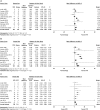Biopsy versus partial versus gross total resection in older patients with high-grade glioma: a systematic review and meta-analysis
- PMID: 25556920
- PMCID: PMC4483123
- DOI: 10.1093/neuonc/nou349
Biopsy versus partial versus gross total resection in older patients with high-grade glioma: a systematic review and meta-analysis
Abstract
Background: Optimal extent of surgical resection (EOR) of high-grade gliomas (HGGs) remains uncertain in the elderly given the unclear benefits and potentially higher rates of mortality and morbidity associated with more extensive degrees of resection.
Methods: We undertook a meta-analysis according to a predefined protocol and systematically searched literature databases for reports about HGG EOR. Elderly patients (≥60 y) undergoing biopsy, subtotal resection (STR), and gross total resection (GTR) were compared for the outcome measures of overall survival (OS), postoperative karnofsky performance status (KPS), progression-free survival (PFS), mortality, and morbidity. Treatment effects as pooled estimates, mean differences (MDs), or risk ratios (RRs) with corresponding 95% confidence intervals (CIs) were determined using random effects modeling.
Results: A total of 12 607 participants from 34 studies met eligibility criteria, including our current cohort of 211 patients. When comparing overall resection (of any extent) with biopsy, in favor of the resection group were OS (MD 3.88 mo, 95% CI: 2.14-5.62, P < .001), postoperative KPS (MD 10.4, 95% CI: 6.58-14.22, P < .001), PFS (MD 2.44 mo, 95% CI: 1.45-3.43, P < .001), mortality (RR = 0.27, 95% CI: 0.12-0.61, P = .002), and morbidity (RR = 0.82, 95% CI: 0.46-1.46, P = .514) . GTR was significantly superior to STR in terms of OS (MD 3.77 mo, 95% CI: 2.26-5.29, P < .001), postoperative KPS (MD 4.91, 95% CI: 0.91-8.92, P = .016), and PFS (MD 2.21 mo, 95% CI: 1.13-3.3, P < .001) with no difference in mortality (RR = 0.53, 95% CI: 0.05-5.71, P = .600) or morbidity (RR = 0.52, 95% CI: 0.18-1.49, P = .223).
Conclusions: Our findings suggest an upward improvement in survival time, functional recovery, and tumor recurrence rate associated with increasing extents of safe resection. These benefits did not result in higher rates of mortality or morbidity if considered in conjunction with known established safety measures when managing elderly patients harboring HGGs.
Keywords: elderly; extent of resection; malignant glioma; meta-analysis; systematic review.
© The Author(s) 2015. Published by Oxford University Press on behalf of the Society for Neuro-Oncology. All rights reserved. For permissions, please e-mail: journals.permissions@oup.com.
Figures




Comment in
-
Biopsy versus resection in the management of high-grade gliomas in the elderly.Neuro Oncol. 2015 Jun;17(6):901-3. doi: 10.1093/neuonc/nov033. Epub 2015 Mar 10. Neuro Oncol. 2015. PMID: 25758747 Free PMC article. No abstract available.
-
Extent of surgical resection of high-grade glioma among the elderly.Neuro Oncol. 2015 Jun;17(6):903-4. doi: 10.1093/neuonc/nov059. Neuro Oncol. 2015. PMID: 26023101 Free PMC article. No abstract available.
References
-
- Hess KR, Broglio KR, Bondy ML. Adult glioma incidence trends in the United States, 1977–2000. Cancer. 2004;101(10):2293–2299. - PubMed
Publication types
MeSH terms
LinkOut - more resources
Full Text Sources
Other Literature Sources
Medical
Research Materials
Miscellaneous

